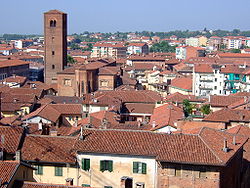Chieri
| Chieri | ||
|---|---|---|
| Comune | ||
| Comune di Chieri | ||

Panorama of Chieri
|
||
|
||
| Location of Chieri in Italy | ||
| Coordinates: 45°1′N 7°49′E / 45.017°N 7.817°E | ||
| Country | Italy | |
| Region | Piedmont | |
| Province / Metropolitan city | Turin | |
| Frazioni | Pessione, Madonna della Scala | |
| Government | ||
| • Mayor | Claudio Martano | |
| Area | ||
| • Total | 54.3 km2 (21.0 sq mi) | |
| Elevation | 305 m (1,001 ft) | |
| Population (31 December 2014) | ||
| • Total | 36,680 | |
| • Density | 680/km2 (1,700/sq mi) | |
| Demonym(s) | Chieresi | |
| Time zone | CET (UTC+1) | |
| • Summer (DST) | CEST (UTC+2) | |
| Postal code | 10023 | |
| Dialing code | 011 | |
| Patron saint | Santa Maria delle Grazie | |
| Saint day | September 12 | |
| Website | Official website | |
Chieri is a town and comune in the Metropolitan City of Turin, Piedmont (Italy), located about 11 kilometres (7 miles) southeast of Turin, 15 km (9 mi) by rail and 13 km (8 mi) by road. It borders the following municipalities: Baldissero Torinese, Pavarolo, Montaldo Torinese, Pino Torinese, Arignano, Andezeno, Pecetto Torinese, Riva presso Chieri, Cambiano, Santena, Poirino.
Between the Neolithic and the Iron Age, the original inhabitants of this part of the Italian peninsula were the Ligures. The Ligures living in this area of the Po river plain belonged specifically to the Taurini tribe.
The location of Chieri is within the Taurini tribe's territory, in the belt of hills which surround Turin. The original settlement was most likely founded by them, being sited on a prominent hill (on which the church of San Giorgio currently stands) and which grew to be the geographical focus of the city centre. Its original name would have been Karreum or a variant thereof e.g. Karreo/Karrea/Carrea: this is based on the root kar, which possibly means "stone", reflecting the typical Ligurian settlement layout of a stone edifice at the centre of a grouping of other habitations within a village, which would have likely been the original layout of Chieri.
Sometime around 400 BCE, Celtic tribes crossed the Alps from Gaul and settled the Po river plain. These peoples mingled with the original Ligures, either through conquest or peaceful cohabitation, and gave rise to a Celto-Ligurian race of people, inhabiting the region which the Romans would call Cisalpine Gaul, i.e. "Gaul this side of the Alps".
...
Wikipedia


